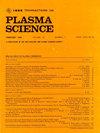封闭条件下温度对空穴缺陷内PD影响的模拟研究
IF 1.3
4区 物理与天体物理
Q3 PHYSICS, FLUIDS & PLASMAS
引用次数: 0
摘要
局部放电检测是气体绝缘开关设备绝缘状态评估的重要组成部分。由于GIS在服务器中会遇到明显的环境温度变化,使得PD的评估变得复杂和不确定。本文旨在通过模拟放电过程,特别是受制造技术限制而不可避免的空穴缺陷内部的放电过程,研究不同温度下pd材料的特性。在普通流体模型的基础上,在电极之间放置两个介电屏障,模拟空穴缺陷内部的局部放电,观察绝缘材料的影响。此外,还提出了参数控制方法来表征不同的放电温度。值得注意的是,放电过程与流传播和净电荷积累相互作用。温度对冲击电离效应有至关重要的影响,它不仅有助于初期的放电发展,而且由于净电荷积累较大而减慢了灭火速度。仿真结果表明,温度越高,峰值越低,持续时间越短。与温度为303 K时的放电相比,323和343 K时的放电电流幅值分别减小了26%和46%,脉冲电流宽度减小了20%和30%,与实验结果一致。我们的研究结果提供了观测到的放电电流与放电温度之间的理论关系,不仅有助于放电环境温度的外推,而且可以推广到其他放电条件。本文章由计算机程序翻译,如有差异,请以英文原文为准。
Simulation Study on the Effect of Temperature on PD Inside Void Defect Under the Closed Condition
The detection of partial discharges (PDs) is an important part of the insulation condition assessment of gas-insulated switchgear (GIS). Due to the GIS in a server encountering obvious ambient temperature change, the evaluation of PD becomes complicated and indeterminacy. This article aims to study the PDs’ characteristics under different temperatures by modeling the discharge processes, especially inside the void defects, which are unavoidable phenomena limited by the manufacturing technology. Based on the common fluid model, two dielectric barriers are placed between the electrodes to simulate the PD inside the void defect and observe the effect caused by insulating materials. Besides, the parameter-controlled approach is proposed to characterize different discharge temperatures. Notably, the discharge process interacts with streamer propagation and net charge accumulation. The temperature has a vital influence on the impact ionization effect, which not only contributes to the discharge development at the beginning but also slows down the extinguishment due to larger net charge accumulation. Simulation results illustrate that higher temperatures contribute to a lower peak value and shorter lasting time. Compared with the discharge at temperature 303 K, the discharge current amplitude decreased by 26% and 46% at 323 and 343 K, respectively, and the pulse current width decreased by 20% and 30%, which is consistent with the experimental results. Our findings provide a theoretical relationship between the observed discharge current and discharge temperature, which not only helps discharge ambient temperature extrapolation but also can be extended to other discharge conditions.
求助全文
通过发布文献求助,成功后即可免费获取论文全文。
去求助
来源期刊

IEEE Transactions on Plasma Science
物理-物理:流体与等离子体
CiteScore
3.00
自引率
20.00%
发文量
538
审稿时长
3.8 months
期刊介绍:
The scope covers all aspects of the theory and application of plasma science. It includes the following areas: magnetohydrodynamics; thermionics and plasma diodes; basic plasma phenomena; gaseous electronics; microwave/plasma interaction; electron, ion, and plasma sources; space plasmas; intense electron and ion beams; laser-plasma interactions; plasma diagnostics; plasma chemistry and processing; solid-state plasmas; plasma heating; plasma for controlled fusion research; high energy density plasmas; industrial/commercial applications of plasma physics; plasma waves and instabilities; and high power microwave and submillimeter wave generation.
 求助内容:
求助内容: 应助结果提醒方式:
应助结果提醒方式:


